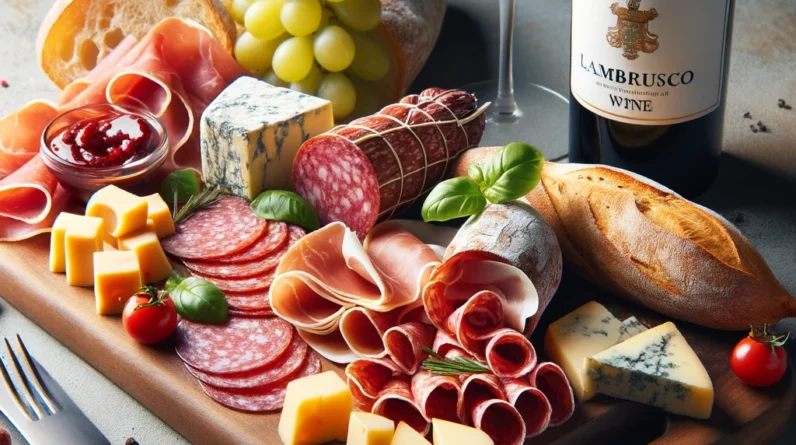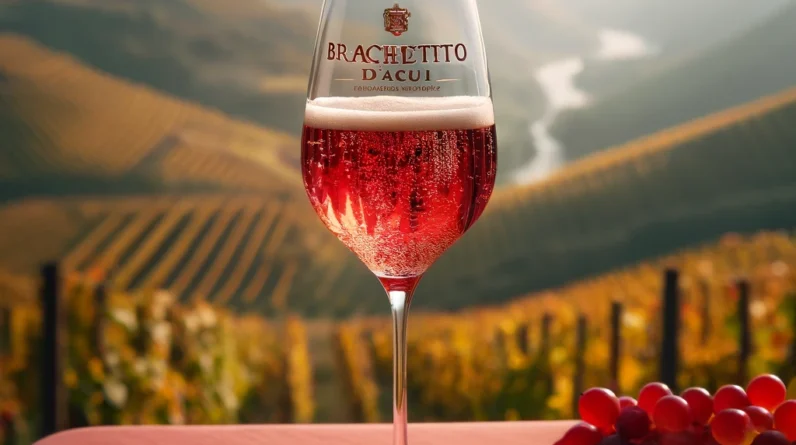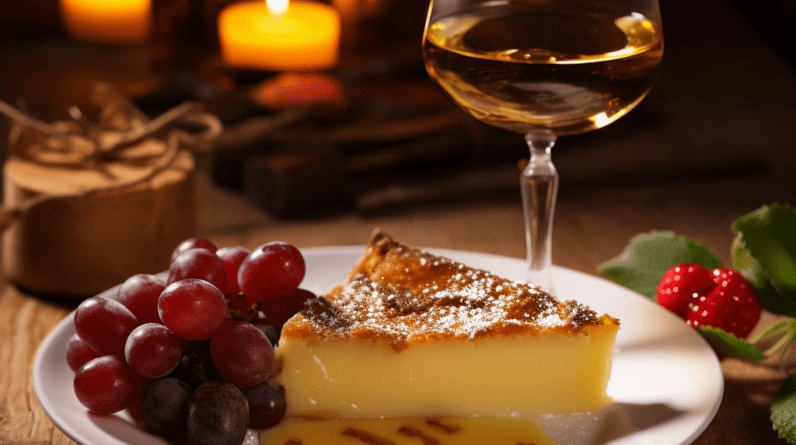
Discovering the Magic of Vin Santo: Perfect Pairings with Traditional Italian Desserts
Welcome to the world of Vin Santo, Italy’s cherished dessert wine.
Often overlooked yet deeply rooted in Italian wine culture, Vin Santo offers a unique experience for wine enthusiasts and culinary adventurers alike.
If you’re familiar with the concept of dessert wines but haven’t fully explored Vin Santo’s potential, this article is your gateway to an exquisite pairing adventure.
What is Vin Santo?
Vin Santo, translating to “Holy Wine,” is a luscious dessert wine from Italy, predominantly Tuscany.
Made from white grapes like Trebbiano and Malvasia, it’s aged in small barrels, acquiring a rich, complex flavor.
Its spectrum ranges from sweet to very sweet, making it an ideal companion for desserts.
Vin Santo has a rich and storied history deeply entwined with Italian culture and tradition.
Its origins and historical significance are as fascinating as the wine itself.
Ancient Roots
The history of Vin Santo can be traced back to the Middle Ages, although there are various theories about its precise origins.
Some believe its history goes back even further, possibly to the times of the Romans.
However, the exact origins remain somewhat shrouded in mystery.
Religious Associations
The name “Vin Santo” suggests a connection to the church and religious rituals.
It’s widely believed that this wine was used during the Mass, which may have contributed to its name and sacred connotations.
The use of Vin Santo in religious contexts helped cement its importance in Italian culture.
Tuscan Tradition
Vin Santo is most closely associated with Tuscany, where it has been produced for centuries.
Tuscan monasteries were known for their wine production, and Vin Santo was often made by monks.
Over time, it became a traditional wine of the region, with each area and even individual producers developing their unique styles.

Legend of the Greek Bishop
One popular legend dates back to the 14th century, involving a Greek bishop who referred to a sweet Tuscan wine as “Xanthos,” which was misheard as “Santo.”
This anecdote, whether true or not, contributes to the folklore surrounding Vin Santo.
Artisanal Production
Historically, Vin Santo was made in small quantities by individual families, often for personal consumption.
It was a wine made from the best grapes, dried to concentrate their sugars, and then aged for several years.
This artisanal, home-made tradition is a crucial part of its heritage.
Symbol of Hospitality
In Tuscany, Vin Santo has long been a symbol of hospitality.
It was traditionally served to guests as a sign of welcome, often accompanied by cantucci (almond biscuits), which guests would dip into the wine.
Evolution and Recognition
Over the centuries, Vin Santo evolved from a rustic, locally consumed wine to a recognized and esteemed product in the international wine market.
Today, it’s celebrated for its quality and uniqueness, with a Protected Designation of Origin status in various Italian regions.
Varietal Diversity
While traditionally made with white grape varieties like Trebbiano and Malvasia, there are also red grape versions (Vin Santo Occhio di Pernice).
This diversity in styles and production methods across different regions of Italy adds to its rich history.
Vin Santo’s history is a tapestry of religious traditions, regional craftsmanship, and cultural symbolism, making it much more than just a dessert wine.
It’s a testament to Italy’s deep-rooted wine heritage and a cherished part of its enological legacy.

Why is Vin Santo So Expensive?
Vin Santo, often regarded as one of Italy’s most prestigious dessert wines, typically commands a higher price due to several key factors.
Complex Production Process
The production of Vin Santo is labor-intensive and time-consuming.
Grapes (usually Trebbiano and Malvasia) are handpicked and then left to dry for several months in a process called ‘appassimento.’
This drying concentrates the sugars and flavors, a crucial step in achieving Vin Santo’s distinctive taste.
This process requires careful monitoring and specific conditions, adding to the cost.
Aging Requirements
Once the drying process is complete, the grapes are gently pressed, and the highly concentrated juice is collected.
The fermentation of Vin Santo is slow and can take several months.
This slow fermentation contributes to the development of complex flavors.
After fermentation, Vin Santo is aged in small barrels, known as ‘caratelli,’ for several years, often between three to ten years, and sometimes even longer.
This extended aging process not only occupies valuable cellar space but also involves a natural reduction in volume due to evaporation (the “angel’s share”), which concentrates the wine’s flavors
but decreases the yield.
Barrel Variability and Maintenance
The barrels used for aging are not completely sealed, allowing for some interaction with the air.
Each barrel develops its unique characteristics, contributing to the complexity of the wine but requiring careful, skilled handling and maintenance.
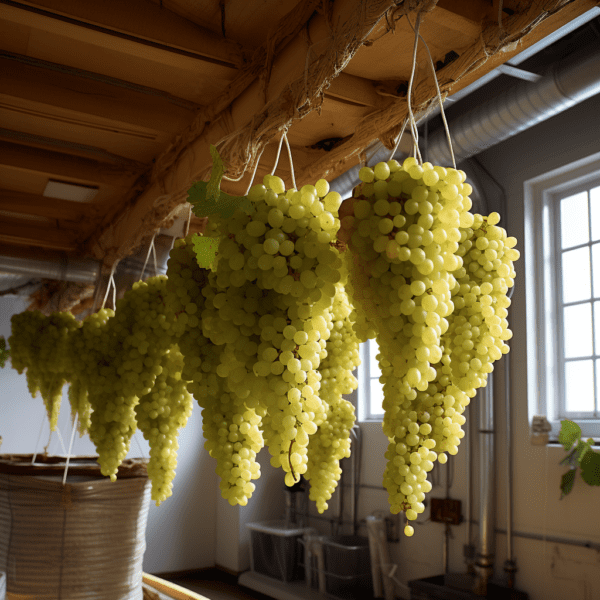
Low Yield
The drying of grapes and the long aging process significantly reduce the volume of wine that can be produced from a given quantity of grapes.
This lower yield naturally results in higher prices per bottle.
Cultural and Historical Significance
Vin Santo holds a special place in Italian wine culture, often associated with tradition and celebration.
This cultural and historical significance can add to its perceived value, making it a sought-after product for connoisseurs and enthusiasts.
Quality and Uniqueness
The unique flavor profile of Vin Santo – rich, sweet, with notes of honey, dried fruit, and nuts – sets it apart from other wines.
Its quality and distinctiveness make it a high-value product in the wine market.
Artisanal Production
Many Vin Santo producers are smaller, artisanal wineries that focus on quality over quantity.
The artisanal nature of its production, often with family-owned wineries having long-standing traditions, adds to its exclusivity and cost.
Given these factors, the high price of Vin Santo reflects the intricate production process, the time and resources invested in its aging, and its unique position in the world of wine.
It’s not just a beverage; it’s a product of meticulous craftsmanship and rich tradition, which is often reflected in its cost.
Pairing Philosophy: Why Vin Santo with Desserts?
The essence of pairing Vin Santo with desserts lies in complementing flavors.
The wine’s natural sweetness and nuanced aromas enhance the taste of various desserts without overpowering them.
It’s a dance of flavors where each sip brings out hidden notes in both the wine and the dessert.

Classic Pairings: A Match Made in Culinary Heaven
Cantucci and Vin Santo
This is the quintessential Tuscan pairing.
Cantucci, almond biscuits, when dipped in Vin Santo, soften, absorbing the wine’s sweetness while enhancing its almond notes.
Best pairing: Cantucci with Avignonesi Vin Santo di Montepulciano: Avignonesi is renowned for their Vin Santo, which exhibits rich, complex flavors of dried fruits, honey, and spices.
This wine’s intensity and elegance make it a perfect match for the almond notes in Cantucci.
Tiramisu
The creamy, coffee-laced layers of Tiramisu find a surprising ally in Vin Santo.
The wine’s sweetness cuts through the richness, balancing the dessert’s texture and taste.
Best pairing: Tiramisu with Felsina Vin Santo del Chianti Classico: Felsina produces a Vin Santo that is beautifully balanced, offering notes of caramel and coffee that can complement the
creamy, coffee-laced layers of Tiramisu.
Its smooth texture pairs well with the dessert’s richness.
Ricciarelli
These soft almond cookies from Siena are a delightful match.
Their chewy texture and sweet marzipan flavor pair beautifully with the nutty and fruity notes of Vin Santo.
Best pairing: Ricciarelli with Badia a Coltibuono Vin Santo del Chianti Classico: Badia a Coltibuono’s Vin Santo, with its sweet marzipan and nutty flavors, is a delightful match for Ricciarelli
cookies.
The wine’s almond and dried fruit characteristics harmonize with the cookie’s similar flavor profile.
Panna Cotta
A silky-smooth Panna Cotta, when drizzled with a reduction of Vin Santo, transforms into a gourmet experience.
The wine adds depth and a hint of acidity to this creamy dessert.
Best pairing: Panna Cotta with Isole e Olena Vin Santo del Chianti Classico: Known for its elegance and balanced sweetness, Isole e Olena’s Vin Santo offers a lighter style that won’t overpower
the delicacy of Panna Cotta.
Its subtle acidity and fruity notes can add depth to the dessert.
Fruit Tarts
Fruit tarts with fresh, seasonal fruits can be elevated with Vin Santo.
Its acidity and sweetness complement the tart’s buttery crust and fresh fruit.
Best pairing: Fruit Tarts with Castello di Volpaia Vin Santo del Chianti Classico: Castello di Volpaia produces a Vin Santo with a bright acidity and fruity undertones, making it an excellent pairing
for fruit tarts.
The wine’s freshness can complement the tart’s buttery crust and fresh fruits.
When choosing a Vin Santo for dessert pairings, consider the intensity and sweetness of both the wine and the dessert to ensure a harmonious balance.
Each of these Vin Santo wines is a fine example of the producer’s craftsmanship and the rich tradition of this unique Italian dessert wine.
Remember, the best pairing is also about personal preference, so feel free to explore and find the combinations that delight your palate the most!
Tips for Serving and Enjoying
Temperature Matters
Serve Vin Santo slightly chilled, around 12-14°C, to appreciate its full bouquet.
Right Glassware
Use small wine glasses to focus the aromas and enhance the tasting experience.
Portion Control
Since it’s sweet and intense, small servings are ideal.
Think of it as a delightful sip to end your meal.
| Dessert | Dessert Explanation | Wine Pairing | Specific Wine | Serving Glass | Serving Temperature |
|---|---|---|---|---|---|
| Cantucci | Traditional Tuscan almond biscuits, known for their crisp texture and nutty flavor. | Vin Santo | Avignonesi Vin Santo di Montepulciano | Small wine glass | 12-14°C |
| Tiramisu | A popular Italian dessert featuring layers of coffee-soaked ladyfingers and mascarpone cheese, dusted with cocoa. | Vin Santo | Felsina Vin Santo del Chianti Classico | Small wine glass | 12-14°C |
| Ricciarelli | Soft almond cookies from Siena, with a chewy texture and sweet marzipan flavor. | Vin Santo | Badia a Coltibuono Vin Santo del Chianti Classico | Small wine glass | 12-14°C |
| Panna Cotta | A creamy Italian dessert made with sweetened cream thickened with gelatin and molded. | Vin Santo | Isole e Olena Vin Santo del Chianti Classico | Small wine glass | 12-14°C |
| Fruit Tart | A dessert consisting of a pastry crust filled with sweet creams, custards, or fruits. | Vin Santo | Castello di Volpaia Vin Santo del Chianti Classico | Small wine glass | 12-14°C |
Exploring Vin Santo pairings with traditional Italian desserts is more than just a culinary exercise; it’s an immersion into a rich cultural tradition.
Each pairing tells a story, bringing to life the flavors and history of Italy.
Whether you’re a seasoned wine lover or just beginning your journey, Vin Santo offers a delightful and enriching experience that transcends the ordinary.
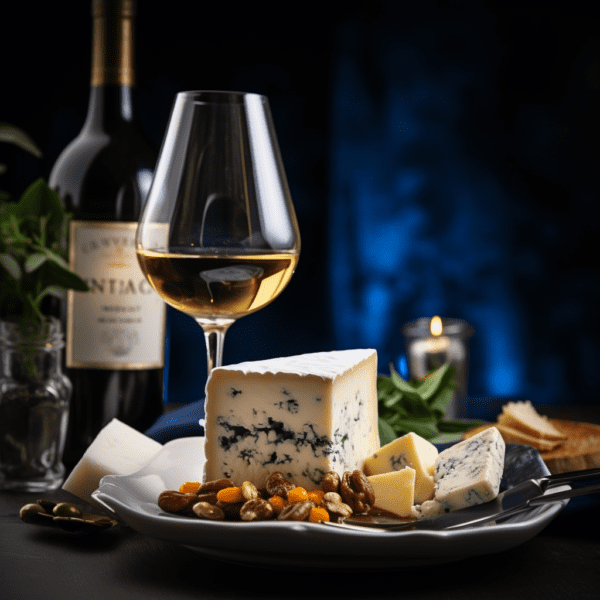
Vin Santo and Cheese Pairings
Vin Santo can be paired with cheese, and it can be a delightful combination when chosen carefully.
The key to a successful pairing is balancing the sweet, rich profile of Vin Santo with the right type of cheese.
Here are some suggestions.
Blue Cheese
The intense, salty, and sometimes pungent flavors of blue cheese, such as Gorgonzola or Stilton, can be beautifully balanced by the sweetness of Vin Santo.
The contrast between the sweet wine and the sharp cheese creates a harmonious blend of flavors.
Aged Hard Cheeses
Aged cheeses like Parmigiano-Reggiano or Grana Padano, which have a nutty and salty profile, pair well with Vin Santo.
The wine’s sweetness complements the savory depth of these cheeses.
Creamy Cheeses
Creamy cheeses, like ricotta or mascarpone, can also pair nicely with Vin Santo.
The wine’s rich texture and sweetness contrast pleasantly with the smooth, mild flavors of the cheese.
Semi-Soft Cheeses
Cheeses with a semi-soft texture and a balanced flavor profile, like Havarti or young Pecorino, can work well with Vin Santo.
The key is to ensure the cheese’s flavor is not too overpowering for the wine.
Fruit-Infused or Spiced Cheeses
Cheeses that have fruits or spices in them can be an interesting match.
The additional flavors in the cheese can bring out different notes in the wine.
When pairing Vin Santo with cheese, consider the intensity of both the wine and the cheese.
The wine should complement the cheese without overpowering it, and vice versa.
Also, consider serving the cheese at room temperature to fully appreciate its flavors with the wine.
This pairing can offer a sophisticated and enjoyable tasting experience, showcasing the versatility of Vin Santo beyond dessert pairings.
FAQs:
Q1: What exactly is Vin Santo?
A1: Vin Santo, which means “Holy Wine” in Italian, is a traditional Italian dessert wine.
Made primarily in Tuscany, it’s produced from white grapes like Trebbiano and Malvasia, which are dried and then aged in barrels for several years.
It’s known for its rich, sweet flavor profile with notes of honey, dried fruit, and nuts.
Q2: How is Vin Santo traditionally served?
A2: Vin Santo is typically served in small quantities at the end of a meal.
It’s best enjoyed slightly chilled, in small wine glasses, to fully appreciate its complex aromas and flavors.
It’s often served with dessert or as a dessert itself.
Q3: Can Vin Santo be paired with savory dishes?
A3: While Vin Santo is predominantly paired with desserts, some drier versions can be paired with savory dishes, especially those with rich, creamy, or cheesy elements.
However, its sweet profile generally makes it more suitable for desserts or as a standalone sip after a meal.
Q4: How long can you store an opened bottle of Vin Santo?
A4: Once opened, Vin Santo can last for several weeks if stored properly.
Keep it in a cool, dark place with the bottle sealed.
Its high sugar content and aging process make it more resilient to spoilage compared to other wines.
Q5: What makes Vin Santo different from other dessert wines?
A5: Vin Santo’s unique production process, involving the drying of grapes and extended barrel aging, imparts distinct flavors and aromas not commonly found in other dessert wines.
Its balance of sweetness and acidity, along with its rich history and Italian cultural significance, also sets it apart.
Q6: Is Vin Santo always sweet?
A6: While most Vin Santo wines are sweet, the level of sweetness can vary.
Some versions are less sweet and more nuanced, offering a broader range of pairing possibilities.
The sweetness level often depends on the winemaking style and the specific grape varieties used.
Q7: Are there different types of Vin Santo?
A7: Yes, there are variations.
Besides the classic white Vin Santo, there’s Vin Santo Occhio di Pernice, made with red grapes, typically Sangiovese, offering a different flavor profile.
Additionally, different regions and producers may have their unique styles and aging processes.
Q8: Can Vin Santo be used in cooking?
A8: Absolutely! Vin Santo can be a wonderful ingredient in cooking, especially in desserts.
It can be used to poach fruits, in reductions for dessert sauces, or even in baking, adding a rich and complex flavor to various dishes.




